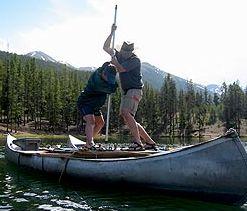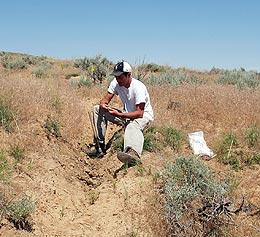University of Wyoming
Source - http://phys.org/news/2013-01-explore-climate-impacts-wyoming-bighorn.html#jCp

Brian Shuman (right), a UW associate professor of geology, and Djuna Gulver, an undergraduate student from the University of Minnesota, collect sediment samples from Emerald Pond in Leadville, Colo.
During the past 13,000 years, Wyoming's Bighorn Basin has experienced significant increases in population growth—due primarily to periods of high effective moisture and moderate temperatures—according to three University of Wyoming professors. By contrast, when water levels were lower and temperatures higher, the state's populations of hunter-gatherers decreased or may have even disappeared altogether, they concur.
The research, presented in a paper titled "A Continuous Climatic Impact on Holocene Human Population in the Rocky Mountains," was published Dec. 24 in the Proceedings of the National Academy of Sciences (PNAS). The organization advises the president and Congress on scientific and technological issues that frequently affect policy decisions at the national level.
Robert Kelly, director of UW's George C. Frison Institute of Archaeology & Anthropology, and lead author of the paper; Bryan Shuman, a UW associate professor of geology; and Todd Surovell, a UW associate professor of anthropology; collaborated on the study by combining their individual research in the Bighorn Basin. Geoff Smith, a former UW graduate student and now a professor at the University of Nevada, also was a co-author.
Kelly and Surovell conducted research of the region's archaeology, studying existing records of radiocarbon data that offered clues as to how old humans were at various times in the Bighorn Basin's history. Shuman studied moisture and temperature levels at different points in time in the basin.
The UW faculty members compared population, moisture and temperature records (primarily using existing data) to evaluate potential linkages between changes in climate and past human populations. Low effective moisture and high temperatures that created an arid environment are both associated with lower population levels, while cooler temperatures and wetter periods led to population growth.
Many archaeological examples emphasize the impact of severe events, but have not resolved the importance of continuous climate change in shaping cultural history, according to the UW researchers.
Humans entered the Bighorn Basin around 14,000 years ago. The UW research group identified five periods of population growth—9,100 years ago, 4,500 years ago, 3,800 years ago, 2,600 years ago and 1,900 years ago. When calculating the years, the researchers started with the year 1950 (the year radiocarbon dating started) as "before present" and worked backward, Surovell says.
While the study produced no exact population numbers during the various periods, Surovell says the group could determine population increases or decreases in relative terms using radiocarbon dating. The dating method uses naturally occurring carbon-14 to estimate the age of carbon-bearing materials as far back as 50,000 years.

Todd Surovell, a UW associate professor of anthropology, examines sediment at the Barnes site located north of Thermopolis.
"We're just now able to reconstruct human population size in pre-history in a way that is reliable and accurate," Surovell says. "For the first time, we are able to see the population of Wyoming or at least a section of Wyoming. Perhaps, it's not surprising that there are more people living in the state when it's cool or wet than when it's hot and dry."
"What we see here is people continually adapting to their environment. But, it's clear that climate controlled how much population there was in the state," Surovell says of the study.
To understand past climate fluctuations, Shuman says he studied layers of fossilized pollen that were trapped in river beds. The pollen helps tell the story of what types of plants and trees grew at particular times, and at what temperatures.
"From the climate side, this research shows me how meaningful climate changes can be," Shuman says. "The Platte River and the Bighorn (River) may have been dry for long parts of the summer (thousands of years ago)."
Based on his findings, Shuman says the average temperature in the Bighorn Basin 7,000 years ago was approximately 1 1/2 to 2 degrees Celsius warmer than it was during the 20th century. While the average person may think a 1 1/2-degree difference in Celsius is miniscule, Shuman says to think again.
For example, if the temperature in the Platte River rises 1 degree Celsius, you would, through evaporation, remove about 230,000 acre feet of water in one year, Shuman says. Today, the Platte River stores about 300,000 acre feet of water in one year.
Without that water in the region, Surovell says that such a small rise in temperature can deplete the amount of plant life which, in turn, can reduce animal numbers. The domino effect continues to the top of the food chain. Without plentiful food to hunt or water to drink due to arid temperatures, populations either migrate or, worse, disappear, Surovell surmises.
"People move or they die," he says. "We don't know if people moved because of the climate or simply died out."
Similar radiocarbon dating studies would need to be conducted in Colorado and Montana to determine whether there were any human migration patterns, Surovell says.
He stresses their findings are relevant today.
"We may be more technologically savvy now and may be able to better adapt to climate change, but we're not immune" to its effects, Surovell says.
Shuman agrees, saying that, in the distant past, if the state's rivers dried up, it impacted Wyoming's population. Today, if the Colorado River dried up, that same scenario would affect the much denser populations of Los Angeles and Phoenix, Shuman says.
Shuman, who also serves as director of the Roy J. Shlemon Center for Quaternary Studies, says this collaboration between the geology and anthropology departments is exactly what the center works to encourage.
More information: www.pnas.org/content/early/2012/12/19/1201341110.abstract